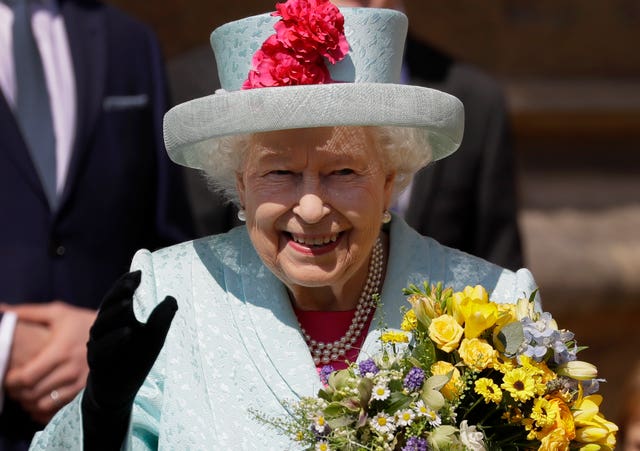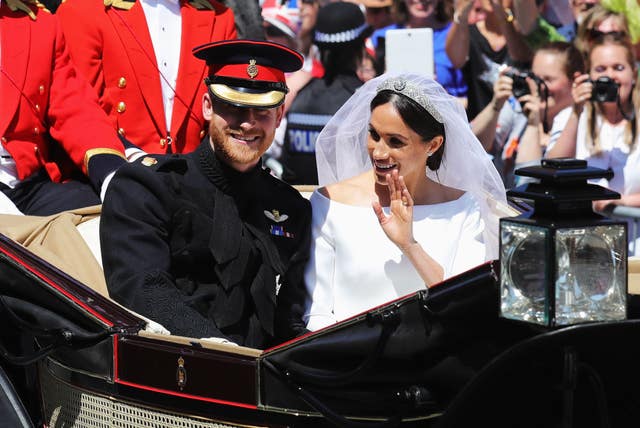The likely title of the Duke and Duchess of Sussex’s baby son links the royal newborn to an ancient Scottish kingdom and the legend of Merlin.
As the son of a duke, the baby is entitled to be known as the Earl of Dumbarton, one of the subsidiary titles given to Harry on the morning of his wedding by his grandmother the Queen.
Harry, in consultation with the Queen, might however decide that his son will not use the title – in which case he could simply be Lord (first name) Mountbatten-Windsor.
 The Queen gave Harry his subsidiary title Earl of Dumbarton on his wedding day (Kirsty Wigglesworth/PA)
The Queen gave Harry his subsidiary title Earl of Dumbarton on his wedding day (Kirsty Wigglesworth/PA)
With Harry and Meghan forging their own path within the royal family, they might even decide not to use any title, with the baby being Master (first name) Mountbatten-Windsor.
But any decision would have to be made with the Queen’s agreement.
READ MORE: Royal Baby – How the line of succession looks now
The Queen could still step in and issue a Letters Patent under the Great Seal of the Realm and make the baby boy a prince.
Founded in the fifth century, the town of Dumbarton, on the River Clyde, west of Glasgow in Scotland, was once the capital of the ancient Kingdom of Strathclyde.
Need some weekend inspiration? Go on one of our great tours of Dumbarton Castle! Booking required: https://t.co/2Ilr0Qrucb @WDCouncil pic.twitter.com/njTretsxFt
— Historic Scotland (@welovehistory) October 27, 2016
Dumbarton Castle sits on the dramatic twin peaks of the 240ft high Dumbarton Rock – a volcanic plug which in-filled the crater of a volcano which was active 350 million years ago.
It guards the point where the River Leven joins the River Clyde.
According to Historic Environment Scotland: “Dumbarton Rock was a mighty stronghold in the Dark Ages.
“Waters swirl around the base of the volcanic rock, which rises almost vertical into the sky.
“From its twin peaks – White Tower Crag and the Beak – you can see for many miles.”
The fort, was according to legend, visited by King Arthur’s wizard Merlin in the 6th century.
Legend has it that #Merlin visited King Riderch of Strathclyde at 'Alt Clut' – the old name for Dumbarton Rock, where #DumbartonCastle now sits. #FolkloreThursday https://t.co/hfODE4OJN5 pic.twitter.com/2vGdPnXNqb
— Historic Scotland (@welovehistory) July 12, 2018
Known as Alt Clut – Rock of the Clyde, it was later called by the Gaelic name Dun Breatann – Fortress of the Britons – from where the name Dumbarton is derived.
Vikings – led by Ivar the Boneless and Olaf the White – later beseiged the fortress, eventually pillaging and destroying it.
READ MORE: How the world welcomed the new royal baby
The medieval castle was built by King of Scots Alexander II in 1220.
It was a cornerstone of medieval royal power and later served as a military base and prison.
An important royal refuge, it was the hiding place for the young Mary Queen of Scots, before she fled to France at the age of five.
In the 1800s, shipbuilding was the major industry in the town of Dumbarton, and it went on to become known for its glassmaking and whisky production.
Its most famous homegrown star is Game Of Thrones actor James Cosmo.
 Dumbarton-born actor James Cosmo (Danny Lawson/PA)
Dumbarton-born actor James Cosmo (Danny Lawson/PA)
BBC Scotland also has drama studios in the town.
Harry became the third person to hold the title the Earl of Dumbarton, and now his son is expected to be the fourth.
Before the Queen gave Harry the title, it had not been used in more than 260 years.
The earldom has strong military connections.
The first to be given it was George Douglas, a younger son of the first Marquess of Douglas, who was created Earl of Dumbarton in 1675.
A Scottish nobleman and soldier, George received the title from Charles II in recognition of his military service.
When James VII of Scots (James II of England) came to the throne in 1685, the earl was made military commander in Scotland, and it is thought that when the King was deposed, George accompanied him to his court in exile in France.
 Harry was made the Earl of Dumbarton on his wedding day and Meghan became the Countess of Dumbarton following their marriage (Christopher Furlong/PA)
Harry was made the Earl of Dumbarton on his wedding day and Meghan became the Countess of Dumbarton following their marriage (Christopher Furlong/PA)
On George’s death at St German-en-Laye in France, the title passed to his son, also called George, who became the second Earl of Dumbarton.
The title became extinct when the second earl died in 1749, until it was handed to Harry.
On marriage, Meghan became the Countess of Dumbarton.
Dumbarton was a Royal Burgh between 1222 and 1975.



Why are you making commenting on The Herald only available to subscribers?
It should have been a safe space for informed debate, somewhere for readers to discuss issues around the biggest stories of the day, but all too often the below the line comments on most websites have become bogged down by off-topic discussions and abuse.
heraldscotland.com is tackling this problem by allowing only subscribers to comment.
We are doing this to improve the experience for our loyal readers and we believe it will reduce the ability of trolls and troublemakers, who occasionally find their way onto our site, to abuse our journalists and readers. We also hope it will help the comments section fulfil its promise as a part of Scotland's conversation with itself.
We are lucky at The Herald. We are read by an informed, educated readership who can add their knowledge and insights to our stories.
That is invaluable.
We are making the subscriber-only change to support our valued readers, who tell us they don't want the site cluttered up with irrelevant comments, untruths and abuse.
In the past, the journalist’s job was to collect and distribute information to the audience. Technology means that readers can shape a discussion. We look forward to hearing from you on heraldscotland.com
Comments & Moderation
Readers’ comments: You are personally liable for the content of any comments you upload to this website, so please act responsibly. We do not pre-moderate or monitor readers’ comments appearing on our websites, but we do post-moderate in response to complaints we receive or otherwise when a potential problem comes to our attention. You can make a complaint by using the ‘report this post’ link . We may then apply our discretion under the user terms to amend or delete comments.
Post moderation is undertaken full-time 9am-6pm on weekdays, and on a part-time basis outwith those hours.
Read the rules hereLast Updated:
Report this comment Cancel